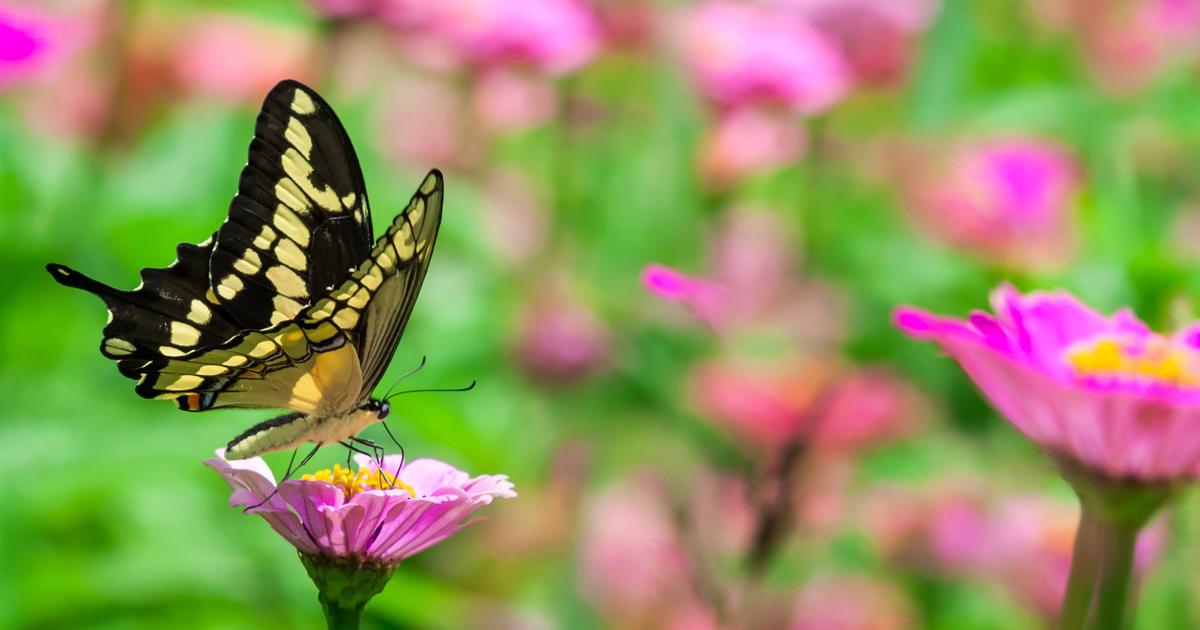The
butterfly
is a pollinating insect belonging to the Lepidoptera family (from the Greek
lepis
, which means scale and
pteron
, wing).
Feeding on the nectar of flowers with its proboscis, it is known to be an essential link in biodiversity with the pollen grains that cling to it and settle on the next flower, in humid environments.
To discover
True or false: fight misconceptions about the garden
This insect goes through four phases:
the egg
the larva (caterpillar)
the chrysalis
the adult (butterfly)
Its lifespan varies between a few hours (as is the case for the ephemeroptera) and ten months (notably the lemon butterfly).
Read alsoButterfly tree, an abundant summer bloom
When is butterfly season?
The chances of crossing it are greater between mid-April and September, sometimes before, if the winter is mild.
It likes when the sun reappears, when the brightness and plant diversity resume because the temperature of this insect depends on that of the outside.
When to observe butterflies?
Butterflies like flower gardens, meadows or forests, when the temperature rises in early spring.
You can approach them slowly, avoiding shading them so as not to scare them or touch their wings, which could weaken them.
Appreciating the heat, the
middle of the day
, between 11 a.m. and 5 p.m., especially in summer, the flying ballet is at its peak.
Read also5 birds to observe in your garden in summer
You can also admire them when their activity is slower, when for example they gather nectar from flowers at the beginning or end of the day or when they take up residence on a plant when the temperature is too low for them to fly away. again, at night or very early in the morning, depending on the region.
How do butterflies spend the winter?
When the cold season approaches, their presence becomes rare and
they overwinter
, especially when they are in the state of egg, chrysalis and caterpillar, hiding in the ground.
Indeed, as a cold-blooded animal, the difficulty of flying is felt because the outside temperature is no longer high enough.
Read alsoGarden: what happens to insects in winter?
In addition, their light weight does not allow them to fight against too strong a wind, an intense breeze or continuous rain.
This is the reason why, during this period, they take shelter: they blend into the environment in which they are, such as a hollow in a tree, a cavity, a nest box, a calm place, at a not too cold temperature.
Its hiding place is safe, safe from predators, waiting for the return of spring and new blooms.
Some so-called more traveling species tend to migrate to more southern areas, where the climate is milder.
What are the most endangered butterflies?
There are
between 150,000 and 175,000 different species
of butterflies in the world - 5,000 listed in France - some of which are threatened and becoming rarer due to construction encroaching on grasslands, the use of pesticides and global warming.
Many of them are therefore protected by the order of April 23, 2007 setting the lists of protected insects throughout the country and the terms of their protection.
"The destruction or removal of eggs, larvae and nymphs, the destruction, mutilation, capture or removal, intentional disturbance of animals in the natural .
»
Article 2 of the decree of April 23, 2007
Among them, there are a wide variety of species:
The Ash Checkerboard
The Ash Checkerboard.
Adobe Stock
The Checkered Ash (
Euphydryas maturna
) of the Nymphalidae family, is recognizable by its brown and orange "checkered" wings.
It is fond of areas of clearings and meadows, particularly in the east of France, but also in the eastern countries of the Old Continent (Germany, Hungary, Austria) and in Central Asia.
The bacchante
The bacchante.
Adobe Stock
The bacchante (
Lopinga achine
) is an insect belonging to the nymphalidae family.
It is distinguished by its light brown color which blends with that of tree trunks and branches.
Its particularity: black circles haloed with a yellow border and a white dot in the center, thus forming like multiple eyes.
Being able to measure between 5 and 6 centimeters, it flies mainly in the center of Europe and Asia in the edges and grassy clearings up to 1,200 meters of altitude.
Wild thyme azure
The azure of wild thyme.
Adobe Stock
The wild thyme (
Phengaris arion),
nicknamed "
little blue
" because of its bluish color and black spots, flies in forest clearings or dry lawns in France and Europe.
the alexanor
The alexanor (
Papilio alexanor
), of the family Papilionidae, is recognizable with its light yellow wings and graphic black bands.
Flying between April and July in the flower meadows of southeastern Europe and Asia up to 1,600 meters above sea level, it can reach a wingspan of 7 centimeters.
The alexanor.
Adobe Stock
Apollo
The apollo (P
arnassius apollo
), from the family of the papilionidae, is identifiable by its white wings colored by black and red circles.
It makes its comings and goings between May and August in the mountain ranges of Europe and Asia up to 2,500 meters above sea level.
Apollo.
Adobe Stock

